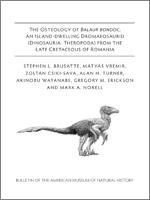Stephen L. Brusatte, Mátyás Vremir, Zoltán Csiki-Sava, Alan H. Turner, Akinobu Watanabe, Gregory M. Erickson, Mark A. Norell
Bulletin of the American Museum of Natural History 2013 (374), 1-100, (13 February 2013) https://doi.org/10.1206/798.1

The Haţeg Island fauna of the terminal Late Cretaceous (ca. 71–65 million years ago) of Romania is one of the most unusual dinosaur assemblages in the global fossil record. It has long been recognized that many herbivorous dinosaurs from the Haţeg fauna were dwarfed, morphologically aberrant, and/or primitive relative to mainland contemporaries, and these taxa are often considered examples of the so-called island effect: the evolutionary phenomenon by which island-dwelling species are often dwarfed and anatomically modified. Very little, however, is known about the carnivorous dinosaurs that inhabited Haţeg Island, and it is unclear whether they were also dwarfed, aberrant, or primitive. In 2009, the discovery of the first substantially complete theropod from the Late Cretaceous of Europe, the holotype of the Romanian dromaeosaurid Balaur bondoc, provided the first clear glimpse at an island-dwelling carnivorous dinosaur. Here we describe and figure this remarkably preserved skeleton in detail. We provide detailed descriptions and photographs of individual bones, and make extensive comparisons with other dromaeosaurids (and other derived coelurosaurian theropods).
This monographic description provides further evidence that Balaur is an unusual derived dromaeosaurid, closely related to Velociraptor, with a remarkably modified hand and foot skeleton, including a stocky and heavily fused distal hind limb, a double set of hyperextensible pedal claws, and a fused and atrophied hand, which are otherwise unknown among derived coelurosaurian theropods. We present an updated diagnosis of Balaur based on additional preparation of the holotype, comparisons with other dromaeosaurids, and careful consideration of postmortem crushing. Histological techniques demonstrate that both the holotype and a referred specimen of Balaur, which is approximately 50% larger than the holotype and from a separate locality, belong to mature individuals. Therefore, we remove the referred specimen from Balaur bondoc and conservatively consider it Balaur sp. We present an updated assessment of the phylogenetic relationships of Balaur based on a comprehensive new coelurosaurian cladistic dataset, which corroborates the close relationship between Balaur, Velociraptor, Deinonychus, Adasaurus, and Saurornitholestes. We review the fossil record of European Late Cretaceous theropods and show that other specimens from the Late Cretaceous of Romania (including the holotype of Elopteryx), France, and Hungary either do not belong to Balaur (due to the lack of Balaur autapomorphies) or cannot be compared to Balaur because of a lack of overlapping material. Finally, we discuss the biogeographic history of European terminal Cretaceous dinosaur faunas and comment on the extreme morphological specializations of Balaur. We conclude that the phylogenetic position of Balaur, a derived dromaeosaurid closely related to Late Cretaceous Laurasian taxa, is inconsistent with previous hypotheses of long-term geographic endemicity of the Romanian island faunas, but argue that the aberrant Bauplan of Balaur is similar to that seen in some living and recently extinct mammals and thus likely due to the “island effect.”

